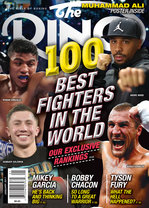Who’s next?: Potential candidates for IBHOF Class of 2018
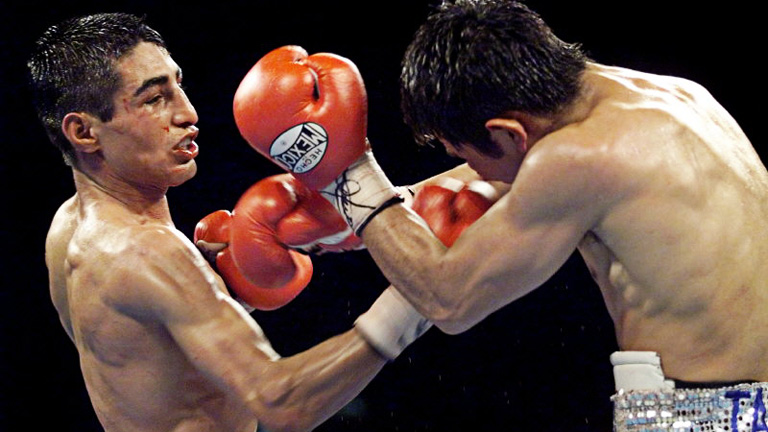
A couple of months ago, I wrote that the International Boxing Hall of Fame’s Class of 2017 could potentially boast the most impressive top-to-bottom roster in many years – maybe even since the massive inaugural class of 1990. That potential became reality on Tuesday as the IBHOF revealed the result of this year’s voting: Evander Holyfield, Marco Antonio Barrera and Johnny Tapia (Modern), Eddie Booker (New Era Old-Timer), broadcasters Steve Farhood and Barry Tompkins (Observers) as well as ring announcer Jimmy Lennon Sr., judge Jerry Roth and trainer Johnny Lewis (Non-Participants). In my eyes, all are deserving and their elevations will help make my 25th trip to the induction weekend that much better.
For me, part of the fun of being an elector is projecting potential first-ballot entries for the following year as well as forwarding other names that are already eligible but, for some reason, have fallen through the cracks.
So which fighters will fill the slots freshly vacated by Holyfield, Barrera and Tapia? Eleven candidates — five first-ballot hopefuls, five already-eligibles and a bonus option – “A Blast From the Distant Past,” if you will – will be profiled here. Not all of them will make it, of course – the whims of the screening committee as well as the electorate that follows them, will always be a wild card – but I believe each deserves his time before the voters. So without further delay, here’s one elector’s fusion of a crystal ball and a wish list:
First-Ballot Eligibles:
Erik Morales – 1993-2012, 52-9 (36): “El Terrible” is not only a lock to get on next year’s ballot; he will probably be boxing’s equivalent of “one-and-done” college basketball players. Enshrinement is a virtual certainty. That’s because the quality of his fistic resume is beyond argument: Major titles in four weight classes (super bantamweight, featherweight, super featherweight and super lightweight), an 18-5 (11) record in title fights (including a 17-1 start) and victories over Daniel Zaragoza (KO 11), Junior Jones (TKO 4), Wayne McCullough (UD 12), Barrera (SD 12 in fight one), Manny Pacquiao (UD 12 in fight one), Kevin Kelley (TKO 7), Guty Espadas Jr. (UD 12, KO 3), In-Jin Chi (UD 12), Paulie Ayala (UD 12), Jesus Chavez (UD 12) and Carlos Hernandez (UD 12) among others. He won his first title from Zaragoza five days after turning 21 and remained a presence on the world scene until his final fight at age 36 in his second fight against Danny Garcia.
That said, there are a couple of factors working against him but both can be mitigated. He was on the short end of his three-fight series with Pacquiao and both losses were by KO but his lone win would be Pacquiao’s only defeat from December 1999 to June 2012. Morales also went 1-2 in his celebrated trilogy against Barrera but the first and third installments were named THE RING’s “Fight of the Year.” That’s a manifestation of Morales’ most endearing quality to fight fans: His willingness to risk everything in his pursuit of victory. While Morales smartly used his height and reach to dominate range, he also forced opponents to confront his ferocious competitive drive as well as his fight-ending power (which was at its peak during his two-and-a-half year, nine-defense reign at 122). If ever a fighter displayed the prerequisite blend of accomplishment, long-term dominance and ring character required of a prospective Hall-of-Famer, it is Morales.
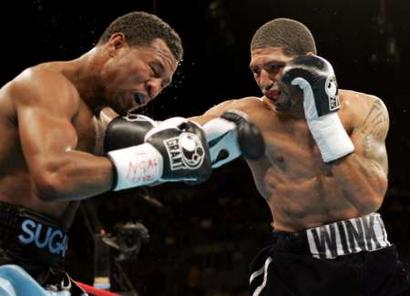
Photo credit: Reuters
Ronald “Winky” Wright – 1990-2012, 51-6-1 (25): While Morales bested opponents with a warrior’s mindset, Wright, to paraphrase Thomas Dolby, blinded them with science. Behind his textbook southpaw stance, “Winky,” a converted right-hander, used his powerful right jab to score points, dominate distance, shred opponents’ defenses and set up the rest of his considerable arsenal. The most important part of his armory, however, was his brain. It’s difficult to make a big mark in boxing without the benefit of one-punch power but Wright’s talent was such that he assembled what I believe is a Hall-worthy resume.
Among his nine defenses in two 154-pound reigns were victories over Bronco McKart (twice in title fights, three times overall) and future titlist Keith Mullings but the three defining fights that will comprise the heart of his HOF candidacy will be his two triumphs over Shane Mosley and his decisive points win over Felix Trinidad in back-to-back-to-back outings. Wright’s first win over Mosley united three of the four major 154-pound titles, spoiled “Sugar Shane’s” planned $10 million payday against Trinidad and vaulted the Floridian into the pound-for-pound conversation. After besting Mosley by majority decision in the mandated rematch, Wright then shocked the world with his overwhelming technical dominance over “Tito,” who had no answers for Wright’s thudding jabs and crisp counters. The scores (120-107, 119-108 twice) and the stats (262-58 overall, 185-15 jabs, 77-43 power and percentage gaps of 35%-10% overall, 32%-5% jabs and 46%-19% power) illustrated the severity of Wright’s schooling of the future Hall-of-Famer.
His points win over Ike Quartey only enhances his candidacy and his blemishes against Fernando Vargas (majority decision loss), Harry Simon (a draw that was changed to a majority decision loss after the fact) and middleweight champion Jermain Taylor (draw) were arguable. Only a pre-prime loss to Julio Cesar Vasquez in his first title shot (in which he arose from five knockdowns, some of which were slips and some of which were legitimate falls) and post-prime defeats to Bernard Hopkins, Paul Williams and Peter Quillin (the last two of which occurred after lengthy layoffs) were decisive. But when Winky Wright was right, he was as right as it got.
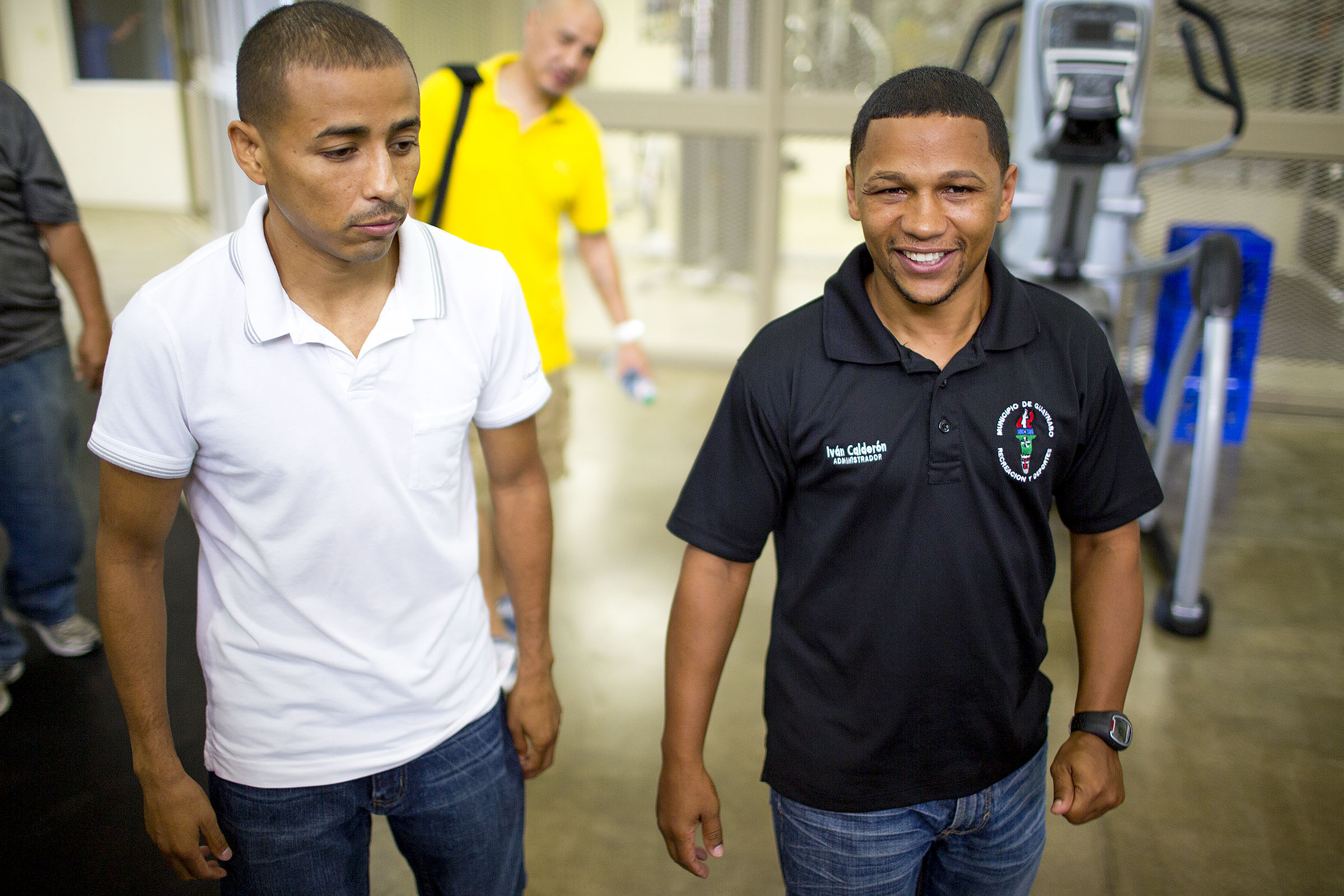
Former RING/WBA/WBO junior flyweight champion Giovani Segura (left) and Ivan Calderon. Photo credit: Joel Colon/PR Best Boxing
Ivan Calderon – 2001-2012, 35-3-1 (6): If Wright was dependent on his brain to win, Calderon, his fellow southpaw, was as reliant on it as any fighter could ever be. Like Billy Conn, Maxie Rosenbloom, Miguel Canto, Tommy Loughran and Nicolino Locche, Puerto Rico’s Calderon ranks among boxing’s most accomplished “singles hitters” as he racked up 11 successful title defenses at 105 and six more at 108 (with only two KO wins) between May 2003 and June 2010 before Giovani Segura snapped his 35-fight unbeaten streak with a shocking eighth-round KO in a WBA/WBO unification bout in August 2010. By then, Calderon had put together an enviable list of conquests: Alex “Nene” Sanchez, Edgar Cardenas, Roberto Leyva, Noel Tunacao, Daniel Reyes, Isaac Bustos, Ronald Barrera, Hugo Cazares (twice), Nelson Dieppa and Rodel Mayol (twice). Except for Barrera and Tunacao, all held a major title sometime in their careers. Calderon’s domination landed him several slots on U.S. pay-per-view shows and, while many criticized his ultra-defensive style and monotonous rounds, others appreciated his defensive skill so much that they shouted “Ole!” whenever he weaved under a sweeping power shot. A Hall-of-Famer needs to demonstrate long-term superiority over quality peers to merit consideration and hopefully the IBHOF’s screening committee will see fit to include this ring general’s name on a ballot in the near future.
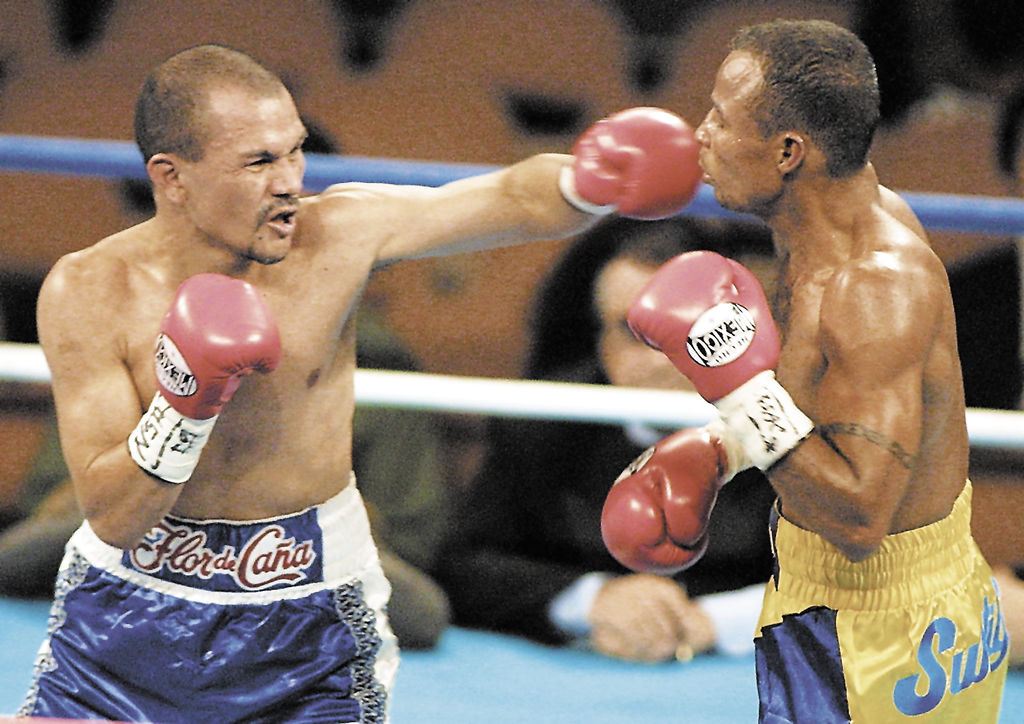
Rosendo Alvarez (left) connects with a left against WBA junior flyweight titlist Beibis Mendoza in March 2001 at the Mandalay Bay Resort and Casino in Las Vegas. Photo credit: Mike Nelson/La Prensa/AFP Photo
Rosendo Alvarez – 1992-2012, 37-4-2 (24): If Calderon was the minimumweight division’s equivalent of quicksilver, then “El Bufalo” was the division’s sledgehammer as he struck with freakishly incongruous power in relation to his small size. The Nicaraguan dethroned long-reigning and previously undefeated (35-0) WBA titlist Chana Porpaoin by split decision before the champ’s home fans in Thailand, then proceeded to establish himself as the definitive rival to WBC counterpart Ricardo Lopez by notching four defenses (and three knockouts) to earn the unification crack against “Finito.” The much-anticipated bout more than lived up to expectations as Alvarez’s pulverizing overhand right dropped the elegant Lopez for the first (and only) time in his Hall of Fame career early in round two, after which he battled the Mexican great on even terms until an accidental butt in round seven opened a gash near the left eye that eventually led to the fight being stopped. The final verdict was a technical draw that would prove to be the only blemish not only of Lopez’s pro career, at that point, but also his entire boxing life.
Their rematch eight months later was a tremendous action fight but Alvarez’s inability to make weight – he missed the limit by 3 1/4 pounds, making him a flyweight in a minimumweight title bout – forced him to give up his WBA strap and force their second meeting to be an over-the-weight affair. Still, the fact that Alvarez was good enough to force Lopez to fully extend himself before gaining victory should also reflect positively on Alvarez’s candidacy. Another factor in his favor was that he won the WBA junior flyweight belt by avenging a disqualification loss to Beibis Mendoza, after which he notched defenses against Pichit Chor Siriwat, Mendoza and Victor Burgos before weight issues again forced him to give up his title before his fourth meeting with Mendoza, who he defeated by split decision to take the series 3-1. Because of those failed wars with the scale (and his penchant for fouling), Alvarez’s chances of induction aren’t as strong as the three aforementioned fighters but his status within his best division merits a look-see from the voters.
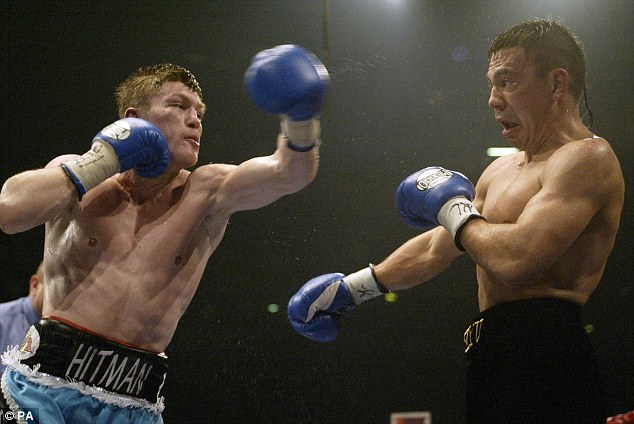
Photo credit: Press Association
Ricky Hatton – 1997-2012, 45-3 (32): “The Hitman’s” legion of fans loved to sing that “There’s only one Ricky Hatton,” and, in terms of everyman charisma and blue-collar work ethic, they may be right. Hatton’s hustle and driving hooks to the body powered him to foundational victories over Giuseppe Lauri (TKO 5), Jon Thaxton (W 12), Freddie Pendleton (KO 2), Eamonn Magee (UD 12), Stephen Smith (W DQ 2), Vince Phillips (UD 12), Ben Tackie (UD 12), Dennis Pederson (TKO 6), Carlos Vilches (UD 12), Michael Stewart (TKO 5) and Ray Oliveira (KO 10) before signing to meet THE RING magazine/IBF super lightweight titlist (and future Hall-of-Famer) Kostya Tszyu, a dominant and respected champion, who was seen as the favorite despite coming to Hatton’s backyard of Manchester. Once the bell sounded, however, the ambitious Hatton’s physicality made Tszyu feel every day of his 35 years. Between rounds 10 and 11, an exhausted Tszyu surrendered on the stool and ignited a roof-blowing outpouring of emotion inside the M.E.N Arena.
Hatton followed that landmark win by adding Carlos Maussa’s WBA strap (KO 9) and Luis Collazo’s WBA welterweight title (UD 12) as well as notching impressive wins over then-IBF super lightweight titlist Juan Urango (UD 12) and Jose Luis Castillo (KO 4) that landed him on the pound-for-pound lists. Later on, he recorded noteworthy victories over Juan Lazcano (UD 12) and Paul Malignaggi (TKO 11). However, if Hatton is to appear on the ballot, voters will have to weigh the successes listed before with the spectacular defeats he suffered against the most elite of competition: A 10th round TKO loss to pound-for-pound king Floyd Mayweather Jr. and a one-punch, second-round KO loss to Mayweather’s pound-for-pound successor Manny Pacquiao. Then, following a three-and-a-half year layoff, Hatton attempted to come back against Vyacheslav Senchenko. Hatton, who had performed well in the early rounds, succumbed to his own defining weapon – a scorching hook to the body – in round nine. Should Hatton make the ballot, his case should ignite interesting debate.
The Already-Eligibles:
Veeraphol Sahaprom – 1994-2010, 66-4-2 (46): The Thai could have been a candidate for the Class of 2016 but against names like Hector Camacho Sr., Lupe Pintor and Hilario Zapata, one could see why he might have been overlooked. That said, Sahaprom, born Teerapol Samranklang, put together a remarkable career that I believe merits a spot on the ballot someday soon as well as ultimate enshrinement.
The Muay Thai veteran shockingly dethroned 64-fight veteran Daorung Chuwatana by split decision to win the WBA bantamweight title in just his fourth professional fight. To that point, only countryman Saensak Muangsurin had ever won a major belt in fewer fights. Not surprisingly, Sahaprom lost the belt just four months later to Nana Konadu, who would become an excellent champion in his own right. But then something incredible happened: Sahaprom won his next 16 fights (11 by KO), then traveled to Japan and won the WBC title by sixth round KO over the charismatic Joichiro Tatsuyoshi. This time, Sahaprom’s tenure would last far longer. How much longer? Try nearly six-and-a-half years and 14 defenses, trailing only Manuel Ortiz’s 15 and Orlando Canizales’ 16 for most consecutive successful defenses in division history.
During his reign, he repeated his victory over Tatsuyoshi (TKO 7) and turned back the challenges of future titlist Toshiaki Nishioka (UD 12, D 12, D 12, UD 12), the 33-1-1 Adan Vargas (UD 12), Hugo Dianzo (UD 12, who many thought deserved to dethrone then-WBA king Paulie Ayala) and Cecilio Santos (UD 12) among others before Hozumi Hasegawa finally loosed his grip by close but unanimous decision in Tokyo, the same city where Sahaprom began his lengthy second reign. Other notable victories beyond his title fights include Willy Salazar (TKO 6) and onetime junior flyweight titlist Rolando Pascua (UD 10).
Here’s an extraordinary stat: After initially losing the belt to Konadu, Sahaprom went 42-0-2 (28) from April 1996 to February 2005. One reason, at least in part, was because he stuffed 13 non-title fights during his second tenure, scoring 11 KO wins. Yes, the level of opposition was middling, at best, but, given the situation, he did exactly what was expected of him: He dominated.
If Sahaprom gets on the ballot, his calling card may be how strongly he rebounded from his loss to Konadu. Most precocious titleholders fade away after losing the belt but Sahaprom not only returned to the top of the mountain, he stayed there for a historically long time. That, to me, is a Hall-worthy feat.
Vuyani Bungu – 1987-2005, 39-5 (19): Bungu first became eligible for the ballot in 2011 but, in a year that also boasted debutantes Mike Tyson, Julio Cesar Chavez and Kostya Tszyu – one of the strongest three-man Modern classes in the Hall’s history – it was easy to overlook the diminutive South African. And considering the potential roster for 2018 and, in subsequent years, it may be a while before he (and the others on this part of the list) get their day. But that doesn’t mean Bungu isn’t worthy; in fact, he is more than deserving of his chance at immortality.
Bungu’s title-winning victory over Kennedy McKinney for the IBF super bantamweight title was so surprising that THE RING deemed it its 1994 “Upset of the Year.” But, in the five years that followed, the man alternately named “The Beast” and “The Carousel Kid” proved himself a world-class operator capable of sustained excellence. During that time, he notched 13 successful defenses, which trails only Wilfredo Gomez’s 17 in division annals. His most important victories were his rematch points win over McKinney, his decision over onetime titlist Jesus Salud and his majority decision against Danny Romero in Atlantic City, one of two U.S. appearances he made as champion (his UD 12 over Johnny Lewus in Biloxi, Mississippi was the other). As is the case with most long title reigns, Bungu defeated names that didn’t move the needle in historical terms but the fact he beat them – and often by decisive margins – speaks well of his overall ability and consistency, especially when one considers he banked more on technique and industriousness than on power as he scored just two KOs during his reign (TKO 2 Pablo Osuna, TKO 7 Victor Llerena II).
In recent years, enshrinees from all corners of the globe have been honored for their talent and resumes. The hall would do well to someday have Bungu join Stanley Christodoulou and Brian Mitchell as immortals hailing from South Africa.
Artur Grigorian – 1994-2009, 38-1 (23): Like Bungu and longtime IBF minimumweight titlist Ratanapol Sor Vorapin (who has been on the ballot for several years), the heart of Grigorian’s nomination, should it be bestowed, would be his record of long-term excellence atop his slice of the boxing universe, which, in his case, was the WBO’s portion of the lightweight championship. Grigorian’s title tenure spanned seven-and-a-half years – second longest to Benny Leonard’s seven year-eight month reign – and 17 defenses, the most ever in division annals. Those two stats alone should merit future inclusion on the ballot and perhaps enshrinement in years that aren’t surrounded by better-known superstars. Maybe his only loss, a 12-round points defeat to Acelino Freitas in his lone appearance on U.S. soil, is why his name hasn’t been floated until now.
Here’s his resume in a nutshell: Following a highly successful amateur career that saw him defeat Shane Mosley in the 1990 Goodwill Games and amass a 361-23 record, Grigorian, a German-based Uzbek of Armenian descent, won the WBO title vacated by Oscar De La Hoya by stopping the hard-hitting Antonio Rivera in 12 rounds. His better title fight wins came against the 102-2 Marty Jakubowski (UD 12), future lightweight titlist Raul Balbi (TKO 11), longtime amateur standout and then-undefeated pro Marco Rudolph (TKO 6), Giorgio Campanella (TKO 10), 24-0 American Michael Clark (an off-the-floor KO 5), Colombian power-puncher Antonio Pitalua (UD 12), the 28-1 Aldo Rios (UD 12), perennial contender Rocky Martinez (TKO 8), former WBA lightweight titlist Stefano Zoff (UD 12) and, in his final successful defense, the 24-0 German prospect Matt Zegan (MD 12). His final win was a six-round decision over fellow 1991 amateur world championship medalist Kirkor Kirkorov, a fight in which the 41-year-old Grigorian emerged from a nearly four-and-a-half year retirement.
Virtually all of Grigorian’s reign was beyond the visibility of American voters at the time but his body of work should deliver him from obscurity and into the light of scrutiny before the Hall of Fame voters. Maybe, just maybe, he’ll come out of that process with a ring on his finger, a plaque on the wall and a legacy worthy of his achievements.
Masamori Tokuyama – 1994-2006, 32-3-1 (8): I once wrote a feature titled “Quantum Leap Fighters” that profiled those who overcame scratchy early careers to achieve excellence at the top levels of the sport. Tokuyama qualifies as one such fighter.
After incurring two losses and a draw in a six-fight span between November 1996 and November 1997, Tokuyama (born Chang Soo Hong in Tokyo but was ethnically North Korean) jump-started his career with a fifth round stoppage over former two-division titlist Hiroki Ioka. Six fights later, he dethroned In-Joo Cho to become the first North Korean to win a major boxing title. Over the next three-and-a-half years, he defended the WBC super flyweight title eight times with Cho, and future champs Gerry Penalosa (twice), Dmitry Kirilov and Katsushige Kawashima among his victims. Kawashima shocked Tokuyama by scoring a 107-second knockout but Tokuyama proved his worth by emerging from an 11-month retirement and regaining the title from Kawashima on points. After outscoring hard-luck American Jose Navarro over 12 rounds in February 2006, Tokuyama, still just 31, announced his retirement and became one of the select few to retire on a title-fight victory.
Compared to Sahaprom, Bungu and Grigorian, Tokuyama’s resume is considerably thinner, in terms of tenure and accomplishments, but I believe it still merits consideration before the voters sometime in the future.
Raul “Jibaro” Perez – 1984-2000, 61-6-3 (42): Perez has theoretically been eligible for the ballot for a decade but, like most overlooked fighters, his barely visible footprint, in terms of notoriety, caused his achievements to be ignored. Hopefully that will no longer be the case.
At 5-foot-10, Perez was among the tallest bantamweight titlists in history and, while he maximized his assets with frequent jabs and long right hands, he also possessed sneaky power. Perez, who turned pro at 17, vaulted into world prominence by stopping former bantamweight titlist Gaby Canizales in nine rounds to raise his record to 34-1. Seven fights later, he out-pointed another former 118-pound titlist in Wilfredo Vazquez Sr. over 10 rounds to earn a crack at longtime WBC bantamweight king Miguel “Happy” Lora on the undercard of Julio Cesar Chavez-Jose Luis Ramirez. The unheralded Perez used his command of range to neutralize the skillful Colombian and score a surprising and lopsided decision. Over the next two-plus years, Perez stuffed in seven defenses and highlights included a blood-soaked points win over Argentina’s Lucio Lopez and victories over Cardenio Ulloa (TKO 8), Canizales (UD 12) and the previously undefeated Gerardo Martinez (TKO 9). Southpaw Jose “Pepillo” Valdez came perilously close to toppling Perez by fighting him to a draw while the speedy Ohioan Greg “The Flea” Richardson used quickness and timely counters to end Perez’s first title run.
Perez bounced back nicely, for in his next fight he won the WBA super bantamweight title from Luis Mendoza by split decision. But that resurgence was short-lived as Vazquez Sr. avenged his previous loss via scorching three round stoppage five months later. Perez responded by jumping up to 130, where he twice challenged fellow HOF nominee Genaro Hernandez. An accidental butt ended the first fight just 28 seconds after the opening bell but in the rematch the prime “Chicanito” thoroughly out-boxed Perez before stopping him in the eighth.
At his best Perez was a skilled fighter capable of beating world-class competition on a consistent basis. Will his prime, which was relatively short-lived, work against him? Perhaps. But keep in mind that others with even briefer primes have earned enshrinement, so for that reason alone Perez should at least get his opportunity before the electorate.
A Blast From the Distant Past:
Marvin Johnson – 1973-1987, 43-6 (35): How long has Johnson been theoretically eligible? He would have been among the pool of fighters for the Class of 1993, my first induction weekend. It’s about time for Johnson’s name to be thrown into the ballot mix.
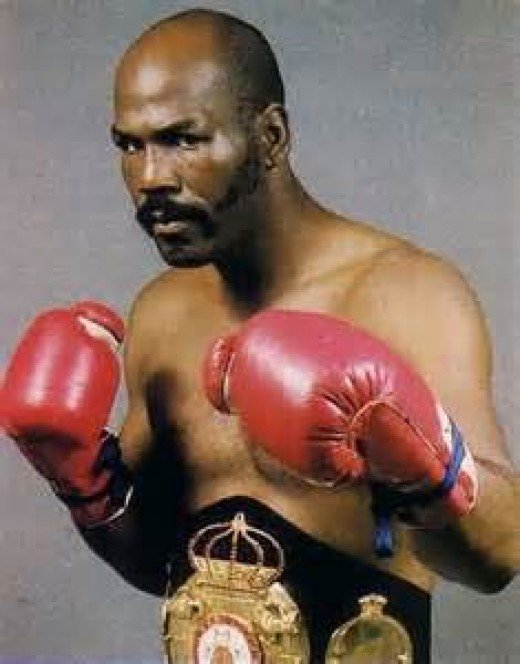
Photo courtesy of Cyber Boxing Zone
Like Modern inductees Danny Lopez, Arturo Gatti, Bobby Chacon, Ray Mancini and Rocky Graziano, Johnson was an all-action hero who provided thrills every time he stepped between the ropes. But while he doesn’t boast the big numbers in terms of title defenses (he just had one in his three reigns) he was a major player in the greatest era the light heavyweight division has ever known.
Those lucky enough to have followed the boxing scene during the late-1970s through the mid-1980s experienced a treasure trove of 175-pounders: Matthew Saad Muhammad, Yaqui Lopez, Victor Galindez, Eddie Mustafa Muhammad, Mate Parlov, John Conteh, James Scott, Dwight Muhammad Qawi, Murray Sutherland, Jerry Martin, Richie Kates, Jessie Burnett, Lonnie Bennett, Jerry Celestine, Johnny and Eddie Davis, Bobby Cassidy, Bobby Czyz, Leslie Stewart, Vonzell Johnson, Mike Rossman, Marvin Camel, Willie Edwards and Michael Spinks among them. For 10 years, these men waged war in a brutal round-robin that produced far more than its share of toe-to-toe action. While most fought during one end of the era or the other, Marvin Johnson was in the thick of it all and he came out the other side as a beloved figure to those who saw it all.
Following an amateur career capped by a bronze medal at the 1972 Olympics in Munich (he lost to eventual gold medalist Vyacheslav Lemechev of the Soviet Union), Johnson clawed his way through the ranks with a take-no-prisoners attack highlighted by arguably the most vicious southpaw left uppercut any boxer ever owned. Johnson was also among history’s fastest starters and many found the opening wave too much to bear. Of his 35 career knockouts, 26 ended in the first five rounds. For all his early-round successes, a casualty was his stamina. No 175-pounder could have maintained Johnson’s early pace, and, at times, that included Johnson.
Johnson was the first light heavyweight ever to win major belts on three separate occasions and of his six career losses, all but one came against fighters who either were or would become champions (Saad Muhammad twice, Spinks, Stewart and Mustafa Muhammad). The sixth defeat, which occurred against onetime title challenger Lottie Mwale, was a disputed eight-round decision. Thus, he more than held his own against his peers.
He defeated Parlov to win his first title (TKO 10 for the WBC belt), Galindez to capture his second title (KO 11) and Stewart to acquire his third (TKO 7). Other victims include Eddie Davis (TKO 7, TKO 5), Johnny Davis (UD 10), Celestine (W 10) and future longtime champ Prince Charles Williams (UD 10). His two losses to Saad Muhammad (TKO by 12 for the NABF belt, TKO by 8 for the WBC belt) rank among the most exciting two-way wars of any era, as was his lone successful defense of his three tenures, his 13th round TKO over Jean-Marie Emebe. Johnson even enjoyed several good moments early against Spinks before a ferocious left uppercut to the jaw left him unconscious in round four. The final fight of his career, an eighth-round TKO rematch loss to Stewart, saw Johnson dropped twice in the first round and absorb a beating that would have felled others several rounds earlier. His skills may have been eroded but the intensity of his fighting heart was as strong as ever. Win or lose, Johnson was always must-see, never-miss viewing.
According to Tris Dixon’s excellent book “The Road To Nowhere: A Journey Through Boxing’s Wastelands,” Johnson was embittered by the fact he never cashed a paycheck large enough to properly convey what he felt he was worth. As someone who watched him ply his trade, only a Floyd Mayweather Jr-Manny Pacquiao -sized check would accurately illustrate Johnson’s excitement quotient. It’s too bad Johnson never secured reputation-confirming showdowns with Thomas Hearns and Bobby Czyz but, absent that, the man affectionately called “Pops” during his third reign should at least receive his chance on the IBHOF ballot. If it’s good enough for Lopez, Gatti, Chacon, Mancini and Graziano, then it’s good enough for Johnson.
I have my thoughts as to which three will occupy next year’s slots but the final decision belongs to the screening committee, who will make their decision sometime next summer. However, it’s clear from this list that plenty of worthy candidates are there for the choosing. That, in the long-term view, is a great thing. But here is some food for thought: Considering the potential logjam of worthy fighters on the horizon, the Hall should consider restoring the four-person Modern class that was in effect from 1994-2005. But that is another issue for another day.
*
Lee Groves is a boxing writer and historian based in Friendly, West Virginia. He is a full member of the BWAA, from which he has won 15 writing awards, including 12 in the last six years and two first-place awards since 2011. He has been an elector for the International Boxing Hall of Fame since 2001 and is also a writer, researcher and punch-counter for CompuBox, Inc. He is the author of “Tales from the Vault: A Celebration of 100 Boxing Closet Classics.” To order, please visit Amazon.com. To contact Groves, use the e-mail [email protected].
Struggling to locate a copy of RING magazine? Try here or…
SUBSCRIBE
You can subscribe to the print and digital editions of RING magazine by clicking the banner or here. You can also order the current issue, which is on newsstands, or back issues from our subscribe page. On the cover this month: THE RING 100.


